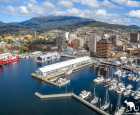The (Museum of Old and New Art), Museum of Ancient and Modern Art is called MONA, for short. It has an avant-garde and legendary background, and there are also many fantastic art exhibitions from time to time.

The legendary life of MONA
The construction of MONA is based on one of the most unlikely revenues-gambling. The $80 million art museum does not rely on any government or institutional funding, solely because of the personal pockets of its owner, David Walsh. The 1961-born man, David Walsh, had three of these labels: math genius, professional gambler, and art collector. It is these seemingly irrelevant identity tags that collide with the legends of David Walsh.

Landing the museum from the wate
MONA is located on the Devon River in Horbart, and it's not surprising that this kind of water-dependent museum has been played out by our rich man: he wants his visitors to land in the museum from the water. So there is the picture of the whole body was painted on the camouflage ship. I heard it was inspired by what the ancient Greeks did to their temples.

Everything starts at the bottom of the hole.
People who have been to MONA have mixed attitudes towards it, and indeed, this strange place from the architectural structure can be said to be one of the most unique and rebellious among the many museums around the world. In fact, as early as we drove to MONA, it was strange that a large museum building, which was far from visible, could not be seen when you were completely close to it. The only visible sight was the mirror wall entrance and the trampoline on the side.

In fact, this is a specially thought-out design. The architect hopes that, rather than conveying the impression of the magnificent figure of the museum itself, it would be better to let everyone naturally enter it and incorporate it into itself.

Get into MONA, to buy tickets, get brochures, and the usual museum tour starts with the next "staff guide," and it's interesting.

As directed by the staff, we went to a cylindrical elevator in the middle of the first floor of the exhibition hall. The outer cover of the elevator is transparent glass, from top to bottom, pervasively erect in the center of the museum. We entered the elevator, pressed the largest number button, and then the elevator began to go down, yes, we were going underground, getting deeper and deeper, and I could even feel that the temperature in the elevator was several degrees lower than just now. When the elevator door opens, everything will start at the bottom of the hole.

“The O”
At the beginning of my first tour, I got a navigation device like the iPhone, which is called "The O."
The significance of "O" lies in the fact that MONA decided at the beginning of its design to abandon the guide tags on the walls of the traditional museum. When I was in a museum that didn't give me any guidance, I went as I felt, with the help of the "O" positioning system and art information. To create my own viewing experience. "O" will position the information of my nearby works, not only to replace the traditional wall-hanging explanatory text and labels, but also to provide me with more rich audio-visual information. For example, when I stopped at a work called text Falls, O gave me a voice interview with the creators.


The curator who is fascinated by death
On the next floor, a tour of the permanent collection will begin, and it has been heard that the collection is worth hundreds of millions of dollars. From ancient Egyptian mummies to modern behavioural art, this is like its name, ancient and modern. But the word "cross-border" seems to describe only the works of art in the museum in formal terms. In the course of my visit, I felt more about the concepts of "private" and "grotesque", because MONA didn't seem to want to cater to the so-called "popular taste" at all. This is the world of David Walsh, where he freely presents his personal artistic preferences.

There are a number of modernist and experimental art shows in the permanent exhibition, such as the death experience, or 150 ceramic female vulva anatomy sculptures neatly lined up on the walls, challenging and impacting your senses. There are also bizarre but well-known exhibits, such as a simulation of the body's digestive system, which is fed regularly every day and excreted after it has been digested.

And in the first little video, the space surrounded by computer and code data, I spent a long time in it, as if I had traveled to an alien space-time.
In addition to adversarial works, there are a lot of gentle and lovely things. For example, this collection of different language versions of "I love you" from different people, you can randomly choose to open the box to listen to, and these are not rigid voices, Because every time you open a box, you receive an emotional confession.
What else? Staff at the pavilion said some of the rooms were bought by the rich man when he was drunk.

I wonder if you are as curious as I am about this rich man. If the answer is yes, I would recommend you to visit MONA's official website: https://mona.net.au/.
In addition to the architecture of some basic information about the museum, the site also has original ecological interviews about the working status of David Walsh and MONA staff. You'll learn more about this freaky, real, cool old man, David Walsh..

By Couple chocolate

